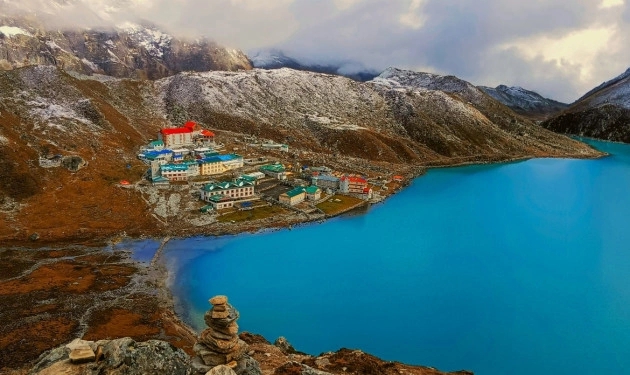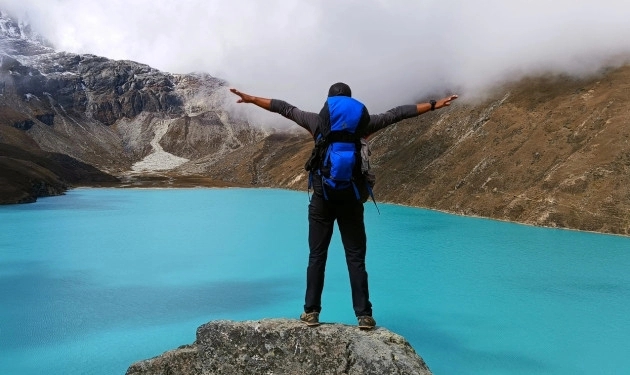Buddhist circuit tour in Nepal
Introduction The birthplace of Lord Buddha, Nepal is deeply influenced by Buddhist teachings, with many places across the country reflecting its prof...

The Gokyo Lake Trek in Nepal is undoubtedly one of the most fantastic adventures in the Himalayas. You will be mesmerized by the views of Everest, enchanted by the glacial lakes, and intrigued by visiting remote Sherpa villages along your trek. However, with altitude, rugged paths, and ever-changing weather, many potential trekkers frequently ask how difficult the Gokyo Lake Trek is and whether it's appropriate for them.
In this extensive guide, we will evaluate the trekking difficulty, preparation, altitude factors and other issues so you can decide if the Gokyo Lake trek suits your fitness level, experience, and trekking ambitions.
The Gokyo Lake Trek is located in the Everest region of Nepal and it allows trekkers to experience a mere fraction of the pure trekking paths through the region. The trek explores the Gokyo Valley, a spectacular area with a series of turquoise-colored glacial lakes, amazing glaciers and the remarkable summit of Gokyo Ri (5,357 m). From the summit, trekkers can observe four of the world's highest mountains, Everest, Lhotse, Makalu, and Cho Oyu.

Duration: 12-15 days (generally)
Maximum Altitude: Gokyo Ri (5,357 m)
Transportation: Fly from Kathmandu to Lukla
Optional Add-ons: Renjo La Pass, Cho La Pass (to Everest Base Camp)
The Gokyo Lake trek overall is moderate to challenging depending upon your previous trekking experience and fitness level. Let's discuss the elements that affect the difficulty level:
The altitude is the big obstacle. At 5,000 meters the oxygen is almost 50% less than at sea level. You could develop Acute Mountain Sickness (AMS).
Namche Bazaar - 3,440 m
Dole - 4,200 m
Machhermo - 4,470 m
Gokyo - 4,790 m
Gokyo Ri - 5,357 m
Prevention Tips:
Ascend gradually
Take acclimatization rest days
Stay hydrated and avoid alcohol
While there is no technical climbing, you need to fit and have good cardiovascular endurance and leg strength.
Steep ascents and descents
Rocky trails and stone steps
Occasional snow or ice patches (especially during transitional seasons like spring and autumn)
On average you will typically be walking for 5–7 hours a day, excluding your summit day on Gokyo Ri which you will need to get up before dawn depending on the season when you will make a very difficult ascent to the summit.
The weather is unpredictable the higher you trek.
The best weather is in Spring (Mar–May) and Autumn (Sep–Nov) when the skies are clear and stable temperatures.
Winter (Dec–Feb) long treks can be cold, with snow and closed to some trails.
Monsoons (Jun–Aug) are not recommended due to the potential for landslides and very poor visibility.
Gokyo is more isolated than Everest Base Camp. There will be fewer teahouses, and there will be no internet service, little medical assistance, and electricity is not always guaranteed.

Acclimatization is an absolute must when it comes to altitude. Most itineraries have incorporated at least one acclimatization day in Namche Bazaar or Machhermo. Use the principle of "climb high, sleep low" to help with getting acclimatized.
Trek at a slow pace even though you feel good.
Be aware of AMS early symptoms: headache, nausea, and dizziness.
If symptoms worsen, descend without hesitation.
Physical Plan to Prepare (6–8 Weeks Prior):
Cardio Training: Running, hiking, swimming, and cycling (30–45 mins, 4–5x/week)
Strength Training: Legs, core, shoulders
Practice Hikes: Load up your backpack on hikes to prepare for a similar trail experience
Having the proper gear for your trek is very important. Below is a brief checklist of items to think about bringing.
Must Have:
Waterproof trekking boots
Down jacket & layers of clothing
Thermal base layers
Sleeping bag (rated to -10°C)
Trekking poles
Reusable water bottle & purification tablets
First aid kit & medicine for altitude sickness
Powerbank/headlamp
Nature Trail is a reputable Trekking & Expedition company in the adventure tourism industry in Nepal. Here are a few reasons why they are great:
All of Nature Trail's guides are trained in first-aid and high-altitude safety, and they have spent years in the Everest region. You will have the confidence of being in safe and knowledgeable hands.
While it is a business, Nature Trail promotes a personalized approach to Nepal trekking. Your trek will be custom including your pace, level of fitness, interests & preferences. Whether you are trekking alone or in a group, Nature Trail will work with you to ensure a personalized experience.
Nature Trail operates under a 'Leave No Trace' philosophy, partners with local communities, and employs local staff. This ensures that the trip you made is benefitting the region it happens in.
They have an emergency back-up for your safety that has a 24/7 service. Nature Trail’s every itinerary has details for acclimatization - an important factor of high-altitude trekking.
This trek is ideal for:
Physically fit and active trekkers (validating with a Trekking Company) that want something less popular than Everest Base Camp, searching for less crowds
Nature lovers who wants unique alpine beauty
You are a beginner to trekking, or have a heart/lung condition and not medically clear
If you can't physically prepare for the trek and invest in the gear.
The Gokyo Lake Trek is an experience and journey through some of Nepal's most beautiful and least travelled Himalayan experiences. While it may not be easy, it is definitely doable with the right physical conditioning, mental preparation, and a professional trekking company like Nature Trail.
If seeking solitude, sacred lakes, and epic mountain views without the high traffic of Everest Base Camp, this trek may be your perfect Himalayan adventure.
Excited to Trek?
If you love the calm lakes, astonishing peaks, and real Himalayan culture, this trek deserves to be on your backpacking list. You will have a secure, memorable, and ethically responsible experience with Nature Trail as you travel.
Start your Gokyo Lake adventure today- where peace meets high-altitude excitement.
It all depends. Gokyo has similar distances and altitude gain but there are less teahouses and could be more difficult trail conditions (certainly if you are going over Renjo La or Cho La). It is considered a little harder because it is less populated and remote.
It is possible for beginners with preparation and a guided trek. If you are in a beginners trek, we suggest being with an experienced company (like Nature Trail) and take the slowest itinerary for acclimatization.
You will need:
Sagarmatha National Park Entry Permit
Khumbu Pasang Lhamu Rural Municipality Entry Permit
Both of these permits are commonly arranged by your trekking company.


Introduction The birthplace of Lord Buddha, Nepal is deeply influenced by Buddhist teachings, with many places across the country reflecting its prof...

The Langtang Trek is a 77 km/48 mi trek in Langtang National Park, allowing views of the Langtang Himalayan range. It is one of the finest short treks...

The Khopra Ridge Trek is one of the less-crowded trekking destinations, located 39.8 km northeast of Pokhara. The beauty of the exceptional landscape...
Discover incredible offers for your upcoming adventure by subscribing to our newsletter with the latest travel tips and updates.
